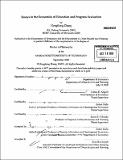Essays in the economics of education and program evaluation
Author(s)
Zhang, Hongliang, Ph. D. Massachusetts Institute of Technology
DownloadFull printable version (9.649Mb)
Other Contributors
Massachusetts Institute of Technology. Dept. of Urban Studies and Planning.
Advisor
Joshua D. Angrist, Esther Duflo and Karen R. Polenske.
Terms of use
Metadata
Show full item recordAbstract
The dissertation consists of three essays studying the economics of education and program evaluation. Chapter 1 examines the impact of attending a magnet school on student achievement using school admissions lotteries in Wuhan, China. Although lottery winners were more likely to attend magnet schools that appear better in many dimensions, including peer achievement, I find little evidence that winning a lottery improved students' performance on the High School Entrance Exam or their enrollment status at elite high schools three years later. Magnet school popularity, measured by either the competitiveness of the admission lottery or the take-up rate of lottery winners, is highly positively correlated with the average student achievement, but largely unrelated to the treatment effect on test scores that I estimate for each school. This evidence suggests that parents value peer quality beyond its effect on achievement gains, or confuse average student achievement with value added. The finding that magnet schools are sought mainly for their observed superiority in average student achievement rather than for their academic value added casts doubt on the potential of school choice to improve student achievement, at least in this context. Chapter 2 studies peer effects on student test scores in middle school using a multi-cohort longitudinal data set from China. I base the identification on variation in peer composition across adjacent cohorts within the same school to control for student sorting across schools and the unobserved school characteristics that affect student outcomes. (cont.) The existing peer effects literature pays little attention to the potential positive correlation in measurement errors between the individual- and the peer-level lagged test score variables, which I find important in my data. Such a positive correlation in measurement errors arises because the individual- and the peer-level lagged test score variables are subject to transitory common shocks due to the continuing presence of a student's former peers in her current peer group. I derive formally that the presence of transitory common shocks on lagged test scores will lead to a negative bias in the estimate of peer effects, and propose an empirical strategy to address this problem by using the lagged test score measures of new peers to instrument for the corresponding lagged test score measures of all peers. The within-school IV estimate of the linear-in-means model shows little evidence that having peers of higher average lagged test score significantly improves a student's test score. Estimates of heterogeneous peer effects models, however, show some evidence in favor of ability tracking. Chapter 3 investigates the nonparametric analysis of randomized program evaluation. Observational problems following randomization sometimes prevent researchers from collecting complete and error-free outcome data. The problem is more serious if sample selection varies by treatment status and interacts with data contamination (imperfect matching). In Chapter 3, I develop a trimming procedure for nonparametric analysis of average treatment effects in the presence of sample attrition and imperfect matching, as well as their interactions. (cont.) I show that, if prior knowledge or a consistent estimator of data contamination rate is available and the treatment status affects sample selection in "one direction," the proposed trimming procedure can construct bounds on average treatment effects for a specific subpopulation whose outcomes would be observed irrespective of treatment assignment status.
Description
Thesis (Ph. D.)--Massachusetts Institute of Technology, Dept. of Economics; and, (Ph. D.)--Massachusetts Institute of Technology, Dept. of Urban Studies and Planning, 2009. Cataloged from PDF version of thesis. Includes bibliographical references.
Date issued
2009Department
Massachusetts Institute of Technology. Department of Economics; Massachusetts Institute of Technology. Department of Urban Studies and PlanningPublisher
Massachusetts Institute of Technology
Keywords
Economics., Urban Studies and Planning.